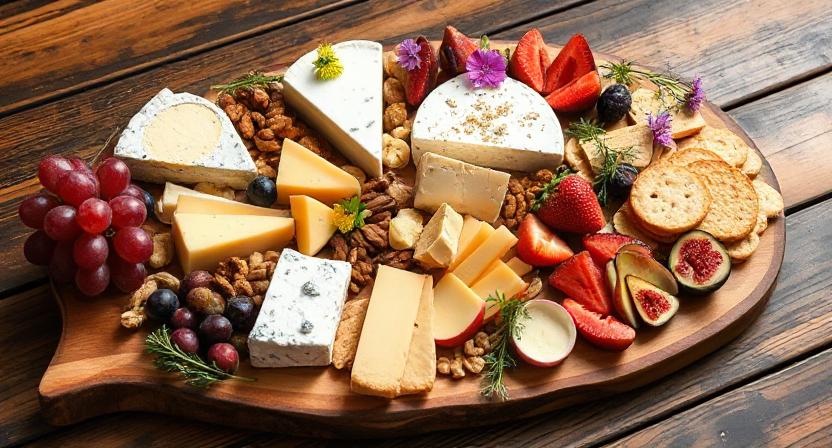Cheese boards are one of the most versatile and elegant elements you can include in any event — whether it’s an intimate gathering, a formal celebration, or a casual party. Not only do they add visual appeal, but they also offer a delightful tasting experience that combines sweet and savory flavors, creating a harmonious balance that delights guests. The secret to a memorable cheese board lies in how you pair cheeses with seasonal fruits, crafting combinations that enhance each ingredient’s unique qualities.
In this guide, we will walk you through the steps to create the perfect cheese board, combining fresh ingredients, contrasting flavors, and attractive presentation. Let’s get started!
1. Choose a Variety of Cheeses: Balance and Diversity

The foundation of a great cheese board is selecting different types of cheeses that provide variety in texture, flavor, and aroma:
- Soft and Creamy Cheeses: Brie, Camembert, Ricotta, Mascarpone. These pair beautifully with juicy, sweet fruits and add luxurious creaminess.
- Semi-Hard Cheeses: Manchego, Gouda, Gruyère, Edam. Mild but flavorful, they work well with sweet or slightly tart fruits.
- Blue Cheeses: Roquefort, Gorgonzola, Stilton. Their bold, salty taste creates a striking contrast with sweet fruits.
- Aged and Hard Cheeses: Parmesan, Aged Cheddar, Pecorino. Perfect for slicing thinly and pairing with crunchy fruits and nuts.
Aim to include at least 3–4 types to provide a diverse tasting experience that caters to different preferences.
2. Select Seasonal Fruits

Using fresh, seasonal fruits elevates your cheese board by adding natural sweetness, acidity, and vibrant color. Here are some ideas based on the time of year:
- Spring: Strawberries, cherries, apricots, rhubarb.
- Summer: Grapes, melons, nectarines, figs, peaches.
- Autumn: Apples, pears, dark grapes, quinces, persimmons.
- Winter: Oranges, mandarins, apples, pomegranates, kiwis.
Slice fruits into thin rounds, wedges, or leave some whole or in clusters for visual interest and easy serving.
3. How to Combine Flavors and Textures
Creating balanced and delicious pairings involves considering the interplay of flavors and textures:
- Soft cheese with juicy fruit: Brie or Camembert with grapes or strawberries offers creaminess complemented by sweetness.
- Semi-hard cheese with sweet, aromatic fruit: Manchego or Gouda with figs or apricots provides a delightful contrast.
- Blue cheese with tart or ripe fruit: Roquefort with pomegranate seeds or ripe pears creates a bold flavor pairing.
- Aged cheese with crunchy fruit: Parmesan or aged Cheddar with crisp apple slices or pear wedges adds texture and complexity.
Don’t forget to include additional ingredients like nuts, honey, jams, or chutneys to enrich the flavor profile.
4. Presentation Tips: How to Assemble an Attractive Cheese Board
Visual appeal is crucial for a memorable cheese board. Here are some tips:
- Arrange cheeses in different areas of the board, possibly elevating some on small stands for visual interest.
- Slice some fruits thinly or into wedges, leaving others whole or in clusters for variety.
- Fill small bowls with honey, jams, or chutneys.
- Include a selection of artisan breads, crackers, or baguette slices.
- Decorate with fresh herbs, edible flowers, or additional fruit for a vibrant, inviting look.
5. Additional Tips for a Perfect Experience
- Serve cheeses at room temperature to maximize flavor.
- Use separate utensils for each cheese and fruit to prevent mixing flavors.
- Place the cheese board in a prominent location with good lighting.
- Pair with wines or beverages that complement the flavors, such as crisp white wines, sparkling wines, or cider.
In Summary: Creating a cheese board paired with seasonal fruits is an art that combines balance, creativity, and good taste. By selecting a variety of flavors and textures and presenting them beautifully, you’ll impress your guests and elevate any celebration. Experiment with different combinations, enjoy the process, and make your cheese board the centerpiece of your event!




